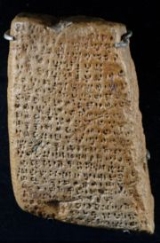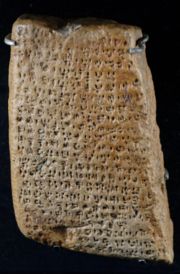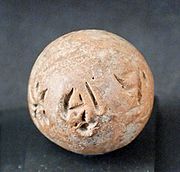
Cypro-Minoan syllabary
Encyclopedia
The Cypro-Minoan syllabary
(abbreviated CM) is an undeciphered syllabic script used on the island of Cyprus
during the Late Bronze Age (ca. 1550-1050 BC). The term "Cypro-Minoan" was coined by Sir Arthur Evans in 1909 based on its visual similarity to Linear A
on Minoan Crete, which CM is thought to be derived from. Approximately 250 objects bearing Cypro-Minoan inscriptions have been found, including clay tablet
s, votive stands, clay cylinders and clay balls. Discoveries have been made at various sites around Cyprus, as well as the ancient city of Ugarit
on the Syrian coast.
The inscriptions have been classified into four closely related groups by Emilia Masson: archaic CM, CM1 (also known as Linear C), CM2 and CM3, although some scholars disagree with this classification. Little is known about how this script originated, or what language was used to write in CM. However, its use continued into the Early Iron Age, forming a link to the Cypriot syllabary
, which reads as Greek and has been deciphered.

discovered in 1955 at the ancient site of Enkomi
, near the east coast of Cyprus. It was dated to ca. 1500 BC, and bore three lines of writing. Other fragments of clay tablets have been found at Enkomi and Ugarit.

, "all past and current schemes of decipherment of Cypro-Minoan are improbable".
Syllabary
A syllabary is a set of written symbols that represent syllables, which make up words. In a syllabary, there is no systematic similarity between the symbols which represent syllables with the same consonant or vowel...
(abbreviated CM) is an undeciphered syllabic script used on the island of Cyprus
Cyprus
Cyprus , officially the Republic of Cyprus , is a Eurasian island country, member of the European Union, in the Eastern Mediterranean, east of Greece, south of Turkey, west of Syria and north of Egypt. It is the third largest island in the Mediterranean Sea.The earliest known human activity on the...
during the Late Bronze Age (ca. 1550-1050 BC). The term "Cypro-Minoan" was coined by Sir Arthur Evans in 1909 based on its visual similarity to Linear A
Linear A
Linear A is one of two scripts used in ancient Crete before Mycenaean Greek Linear B; Cretan hieroglyphs is the second script. In Minoan times, before the Mycenaean Greek dominion, Linear A was the official script for the palaces and religious activities, and hieroglyphs were mainly used on seals....
on Minoan Crete, which CM is thought to be derived from. Approximately 250 objects bearing Cypro-Minoan inscriptions have been found, including clay tablet
Clay tablet
In the Ancient Near East, clay tablets were used as a writing medium, especially for writing in cuneiform, throughout the Bronze Age and well into the Iron Age....
s, votive stands, clay cylinders and clay balls. Discoveries have been made at various sites around Cyprus, as well as the ancient city of Ugarit
Ugarit
Ugarit was an ancient port city in the eastern Mediterranean at the Ras Shamra headland near Latakia, Syria. It is located near Minet el-Beida in northern Syria. It is some seven miles north of Laodicea ad Mare and approximately fifty miles east of Cyprus...
on the Syrian coast.
The inscriptions have been classified into four closely related groups by Emilia Masson: archaic CM, CM1 (also known as Linear C), CM2 and CM3, although some scholars disagree with this classification. Little is known about how this script originated, or what language was used to write in CM. However, its use continued into the Early Iron Age, forming a link to the Cypriot syllabary
Cypriot syllabary
The Cypriot syllabary is a syllabic script used in Iron Age Cyprus, from ca. the 11th to the 4th centuries BCE, when it was replaced by the Greek alphabet. A pioneer of that change was king Evagoras of Salamis...
, which reads as Greek and has been deciphered.

Clay tablets
The earliest known inscription in CM was a clay tabletClay tablet
In the Ancient Near East, clay tablets were used as a writing medium, especially for writing in cuneiform, throughout the Bronze Age and well into the Iron Age....
discovered in 1955 at the ancient site of Enkomi
Enkomi
This article is about the town and ancient settlement near Famagusta. For the suburb of Nicosia , see: Engomi.Enkomi is a village near Famagusta on Cyprus. It is the site of an important Bronze Age city, possibly the capital of Alasiya...
, near the east coast of Cyprus. It was dated to ca. 1500 BC, and bore three lines of writing. Other fragments of clay tablets have been found at Enkomi and Ugarit.
Clay balls
Dozens of small clay balls, each bearing 3-5 signs in CM1, have been uncovered at Enkomi and Kition.
Clay cylinders
Clay cylinder seals have been uncovered at Enkomi and Kalavassos-Ayios Dimitrios, some of which bear lengthy texts (more than 100 characters). It is likely that the balls and cylinder seals are related to the keeping of economic records on Minoan Cyprus, considering the large number of cross-references between the texts.Decipherment
The extant corpus of Cypro-Minoan is not large enough to allow for the isolated use of a cryptographic solution to decipherment. Currently, the total number of signs on formal Cypro-Minoan inscriptions (approx. 2500) compares unfavorably with the number known from the undeciphered Linear A documents (over 7000) and the number available in Linear B when it was deciphered (approx. 30,000). Furthermore, different languages may have been represented by the same Cypro-Minoan subsystem, and without the discovery of bilingual texts or many more texts in each subsystem, decipherment is extremely unlikely. According to Thomas G. PalaimaThomas G. Palaima
Thomas G. Palaima is a Mycenologist, the Raymond F. Dickson Centennial Professor and the founding director of the Program in Aegean Scripts and Prehistory in the Department of Classics at the University of Texas at Austin....
, "all past and current schemes of decipherment of Cypro-Minoan are improbable".
Recent developments
- In 1998, Joanna S. Smith and Nicolle Hirshfeld received the 1998 Best of Show Poster Award at the annual meeting of the Archaeological Institute of America for their work on the Cypro-Minoan Corpus project, which aims to create a complete and accurate corpus of CM inscriptions, and archaeological and epigraphical discussions of all the evidence.

